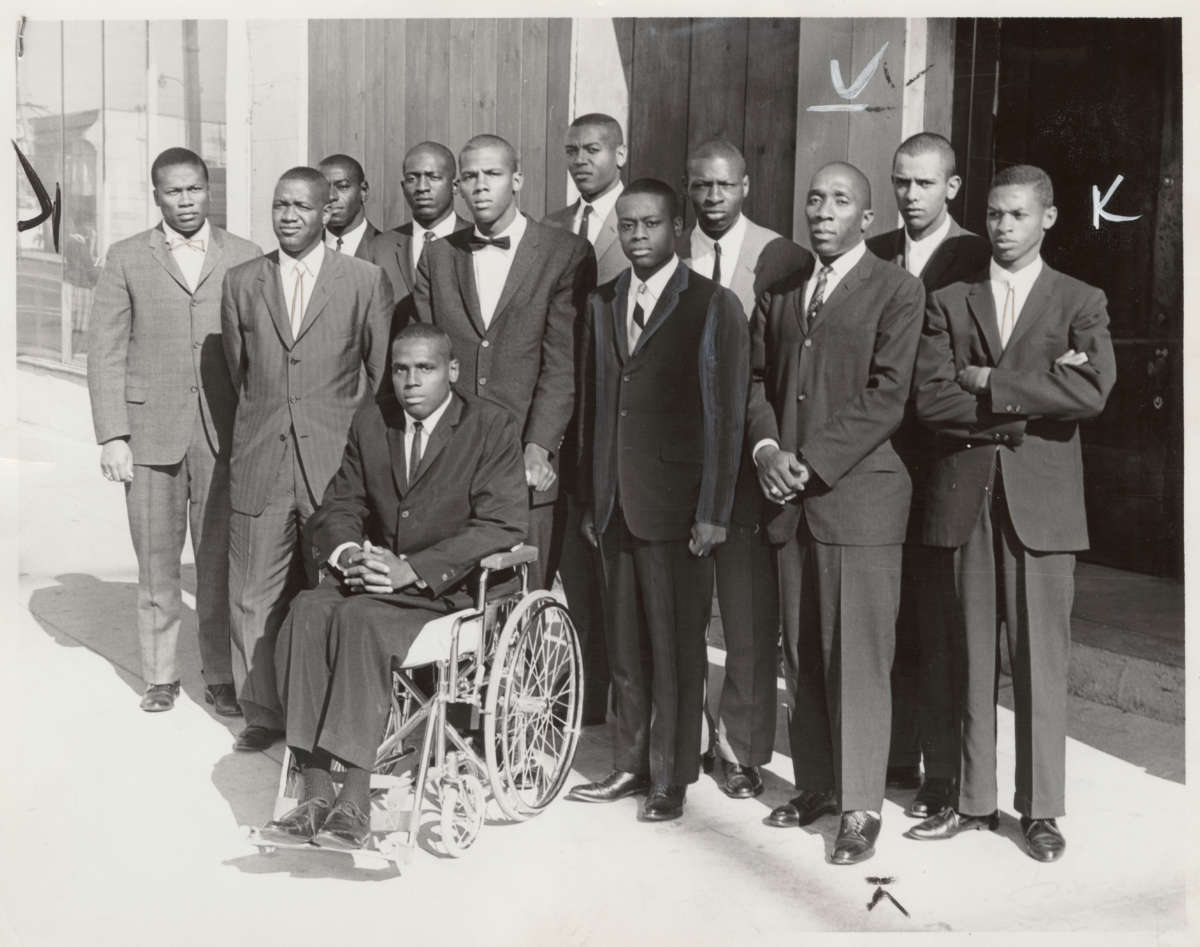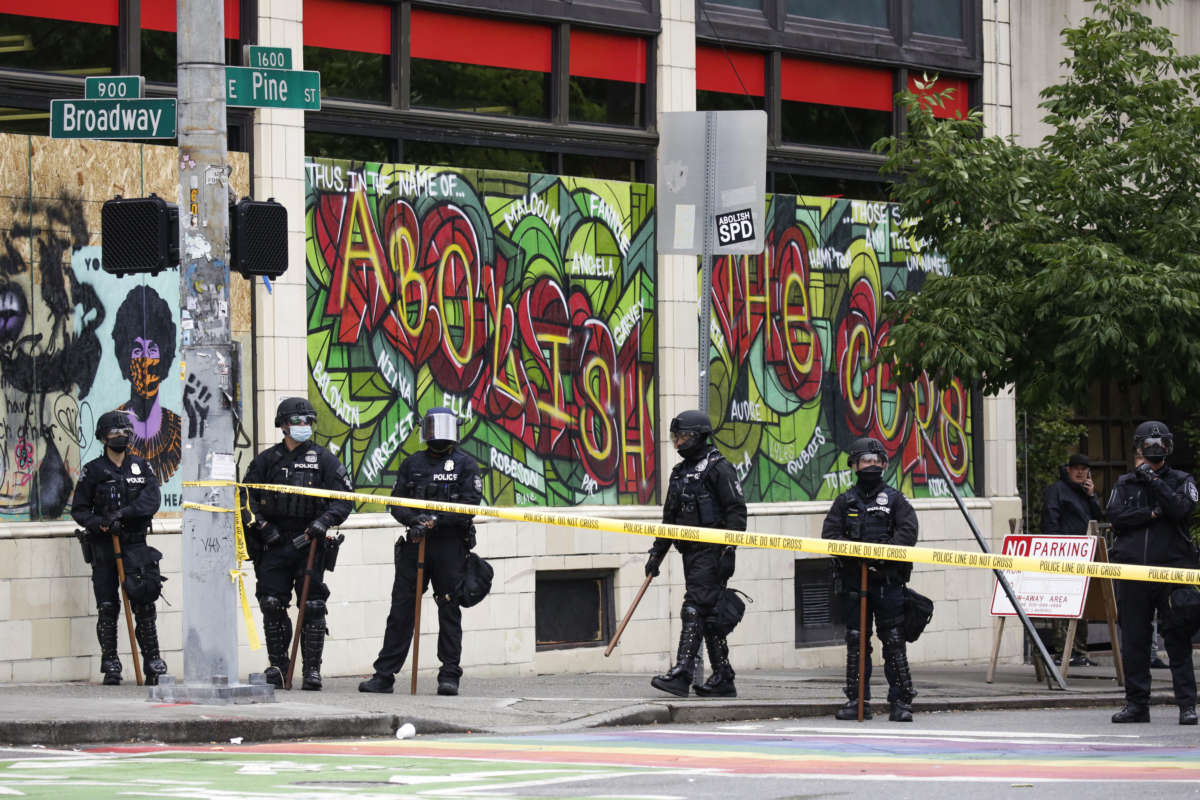Police Reform Hasn’t Stopped the Killings Before. It Won’t Now Either.
President Trump signed an executive order on police reform this June that was more a defense of policing than an indictment. Democrats assembled in their usual formation to say it did not go far enough. But amid crystal-clear calls from protesters in the streets to defund the police, there is bipartisan agreement among national politicians to do just the opposite: fund them. As presumptive Democratic candidate and major architect of mass incarceration Joe Biden saidrecently, “Every single police department should have the money they need to institute real reforms.”
History tells us that mass incarceration — and the police who act as its foot soldiers — have always been a bipartisan project. Political scientist Naomi Murakawa documents in her book The First Civil Right: How Liberals Built Prison America how the midcentury movement for “police professionalization” marked an earlier consensus to fund the police. “Some saw police funding as a way to repress rioting and law-breaking; others saw police funding as a way to suppress impetuses for rioting by improving ‘police-community- relations.” Both saw resources for policing — not its defunding and dissolution — as the answer.
These staged partisan disagreements on reform are a counter-revolutionary tactic. They aim to further enshrine policing into the fabric of our society. As historian Stuart Schrader points out, “police reform is not designed to help citizens. It is designed to help police.” Police reform is a time-honored counter-insurgency measure to quell rebellion.
During the Watts rebellion in 1965, with the South Los Angeles neighborhood in flames, similar reforms were proposed: citizen review boards, bias trainings, diversifying the police force. And the police murder of a Black Muslim man, Ronald Stokes, years earlier — one that many viewed as the kindling for the rebellion — is particularly instructive in our current moment.
The surveillance of the daily lives of Muslims leading up to Stokes’s death and the liberal reforms which precipitated and followed it, can inform current discussions about reform and abolition. Indeed, the murder of Ronald Stokes happened in a city whose police department was heralded as a national model for police professionalization and reform.
The Fatal Results of Police Professionalization
On the evening of April 27, 1962, Monroe Jones and Fred Jingles were unloading suits out of the back of a Buick in front of the Nation of Islam’s (NOI’s) mosque in South Los Angeles when two white officers stopped them. What was described in the Los Angeles Times as a “blazing gunfight” and a “riot” left seven unarmed Muslims shot by police. One man, William Rogers, was paralyzed from the waist down, and mosque secretary Ronald Stokes was shot through the heart at close range while walking towards a white police officer with his hands raised in prayer. As the others lay on the ground handcuffed and bleeding, they held hands and chanted Allāhu akbar, “God is most great.”
But before being hailed with police bullets that night, Muslims were surveilled for years and routinely harassed for selling newspapers. Then, as now, policing was defined by a continuum of violence against communities, rather than their protection from it. Police Chief William Parker himself proudly admitted that “we have been watching [them] with concern for a long time.”
Parker was a leading national reformer in the push for police professionalization. He was also famous for popularizing the term the “thin blue line” and describing police as the “greatest dislocated minority in America.” He did this all while overseeing a police force so brutal that the generally moderate civil rights leader Roy Wilkins compared Los Angeles police as “next to those in Birmingham, Alabama.”
The Monday before Stokes was murdered, 10 Muslim men drove to the University of California, Los Angeles campus to sell copies of the NOI’s newspaper, Muhammad Speaks. There, they were hassled by police officers who asked whether they were students and demanded their identification. Arthur Coleman refused. Four days later, Coleman had his head lacerated by a gun butt and was shot in his chest and the base of his penis by Donald Weese, the same officer who killed Stokes. He was then handcuffed and left lying on the ground. Policing the sale of newspapers on a college campus was part of the daily surveillance and profiling that served as the precursor for the fatal violence later that week.
This is not a contradiction. Huddled together under the umbrella of police professionalization was racial bias training and wiretapping, crime data and racial and religious profiling. The purpose of police professionalization was to broaden the scope of policing while shielding it from public scrutiny and oversight.
The Everyday Violence of Policing
Exceptional violence begins with the quotidian. The daily policing of everyday Black life is a sustain pedal punctuated by the staccato notes of police murder which have catalyzed current uprisings. Trayvon Martin was killed over Skittles and a can of iced tea. Eric Garner was choked to death over selling cigarettes. Sandra Bland’s death was prompted by a traffic stop. George Floyd was murdered over a $20 bill. Rayshard Brooks was sleeping in his car. The murder of Ronald Stokes began with two men unloading suits from the back of a Buick.
When Jones and Jingles were stopped and asked by police “if they were Muslims,” they demanded to know why they were being questioned. One officer cited high rates of crime in the area and suggested the suits may have been stolen. A scuffle ensued, and a Black off-duty police officer intervened by slamming a blackjack club against one of the men’s heads. What began as two officers questioning men who were unloading laundry, ended with a half-dozen men shot and one dead. Officer Donald Weese alone was responsible for shooting five of the men. Yet, the grand jury ruled Stokes’s murder justifiable homicide.
If history is any guide, liberal professionalization reforms such as community relations training, racial diversification and data analysis will not change the violent outcome of police murder. To the contrary, the backdrop to the deadliest case of police violence in the 30-year history of the Nation of Islam included all three.
In Los Angeles, it was the victims of police violence, not police, who eventually went on trial. The state brought 40 counts of assault and resisting arrest against 14 defendants. The trial set the record for longest jury deliberation in Los Angeles history. Over 18 anguishing days, Malcolm X and supporters held vigils outside the courthouse while 200 police with nightsticks patrolled around them. In the end, 11 of the 14 men were found guilty. Herbert Rogers, whose son William was sentenced on assault charges while sitting in a wheelchair paralyzed from police bullets, summed up the trial most succinctly: “You can’t get a fair trial in a white man’s court.”


Police Reforms Fail Because They Were Never Designed to Succeed
When the Watts Rebellion erupted three years later in response to police violence, many considered the murder of Ronald Stokes the origin. Ruth Robinson, a Black teacher who was herself a victim of police brutality and had tried to sue the city for years, recalled joining the organized fight against police violence after Stokes’s killing. Longtime civil rights attorney Loren Miller, who represented the Muslims at trial, had ominously forecast a year before Watts that “violence in Los Angeles is inevitable and nothing can or will be done about it until after the fact.”
Between 1963 and 1965 alone, police had killed 60 Black people in Los Angeles; 25 were unarmed and 27 were shot were in the back. Yet the reforms proposed after Stokes’s murder in 1962 were again mirrored in 1965: civilian review boards, diversified police forces, community relations committees, speaker’s bureaus — in short, pacification projects. Even the liberal-minded Miller condemned the McCone report commissioned after Watts as a “bitter disappointment” which “prescribes aspirin where surgery is required.”
What does this mean in our current moment that liberal police reforms preceded and followed Stokes’s murder? When Malcolm X spoke to the press about the killing, he emphasized that “this happened in Los Angeles.” A police force known nationally for its modernization and professionalization did not change its reputation among Black Angelinos as a violent occupying army. It did not stop Ronald Stokes from being murdered, or William Rogers from being paralyzed, or Watts from burning.
As Angela Y. Davis pointed out, we are “trapped on a treadmill of reform.” But reform does not stop the killings. Although reformist solutions such as #8CantWait focus on banning various forms of excessive force, daily policing is predicated on the possibility — indeed the inevitability of — excessive force. It is for this reason that historian Micol Seigel has described policing as “violence work.”
Mariame Kaba cautioned that when “the streets calm and people suggest once again that we hire more Black police officers or create more civilian review boards, I hope that we remember all the times those efforts have failed.”
They have failed because they were never designed to succeed. There is no “excessive use of force” uncoupled from the everyday violence of surveilling Black life. The murder of Ronald Stokes was inextricably bound in the harassment of Black Muslim men selling newspapers and unloading suits. Those practices were embedded in reforms. To truly end police violence, we must end policing itself.




Geen opmerkingen:
Een reactie posten